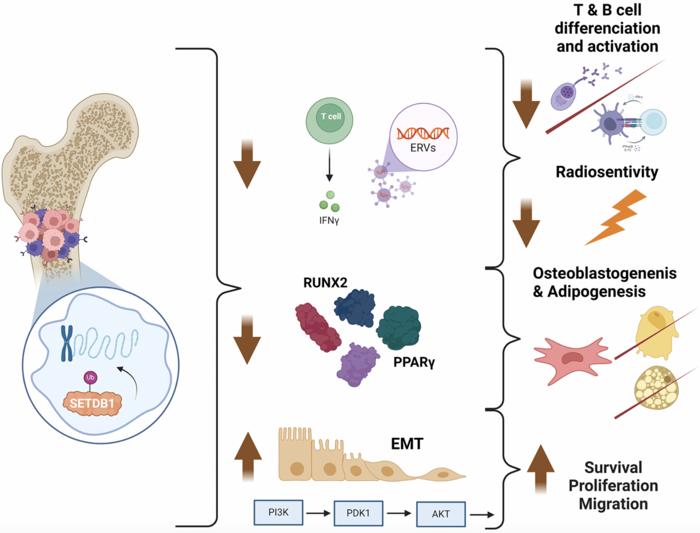
SETDB1 amplification in osteosarcoma presents a striking development in oncology research, showcasing the intricate relationship between genetic anomalies and cancer progression. Recent findings suggest that the SETDB1 gene plays a pivotal role in the biology of osteosarcoma, a malignancy primarily affecting adolescents and young adults. This new understanding, outlined in a comprehensive review published in Oncotarget, opens new avenues for potential therapeutic interventions, signaling a significant advancement in the battle against this aggressive cancer.
Osteosarcoma is notorious for its rapid progression and high mortality rates, often leading to a grim prognosis for patients. Traditionally, treatment protocols for this form of cancer have revolved around surgical intervention and chemotherapy. However, these approaches frequently fall short, especially when the cancer exhibits multidrug resistance or metastatic spread. The recent emphasis on the genetic underpinnings of osteosarcoma has shed light on SETDB1, whose amplification appears to correlate with aggressive disease phenotypes.
The involvement of SETDB1 in cancer is primarily linked to its role in epigenetic regulation. Unlike genetic mutations that alter the DNA sequence, epigenetic modifications affect gene expression without changing the underlying genetic code. SETDB1’s influence on gene expression profiles suggests it may serve as a regulator of tumor biology, influencing how cancer cells proliferate, evade therapeutic strategies, and avoid immune detection. This mechanism provides researchers with substantial insights that could pivot the direction of future osteosarcoma treatment paradigms.
Recent whole-exome sequencing studies emphasize that the amplification of SETDB1 is not merely a byproduct of cancer progression but a contributing factor to the aggressive nature of osteosarcoma. Analysis of tumor samples revealed that cells exhibiting SETDB1 dysregulation often had augmented kinetic responses to growth stimuli, suggesting a direct relationship between SETDB1 levels and cancer aggressiveness. By understanding these dynamics, scientists are hopeful that strategies targeting SETDB1 could reverse the trends of poor outcomes associated with this disease.
One of the critical challenges in cancer therapy is the ability of malignant cells to develop resistance to treatment modalities, particularly chemotherapy. Data indicates that idiopathic amplification of SETDB1 may fortify osteosarcoma cells against commonly used chemotherapeutic agents, effectively nullifying their therapeutic potency. This resistance accentuates the urgency of identifying and validating treatment avenues that target this specific epigenetic landscape.
Furthermore, immunogenicity is another area where SETDB1’s role manifests significantly. Tumors often employ various strategies to evade recognition by the immune system. The SETDB1 protein may facilitate the silencing of genes essential for antigen presentation, thus shielding tumor cells from immune surveillance. By developing drugs that inhibit SETDB1, researchers aspire to resurrect immune system functions, enabling it to distinguish and target cancerous cells more effectively.
Cumulatively, the findings from the Gustave Roussy Cancer Campus pave the way towards a dual approach: combining SETDB1 inhibition with existing therapies, including chemotherapy and immunotherapy, could enhance treatment efficacy. This synergy may create a robust treatment framework that not only hinders cancer cell proliferation but also re-sensitizes them to standard therapeutic agents.
Researchers are already exploring various pharmacological agents that can effectively inhibit SETDB1 function. These experimental drugs show promise in in vitro studies by disrupting the protein’s interaction with critical signaling pathways involved in cancer progression. As these efforts advance, early clinical trials could soon determine the translational viability of targeting SETDB1 in osteosarcoma patients.
The review published in Oncotarget emphasizes that while progress is palpable, significant hurdles remain. Continued investigation into the biological implications of SETDB1 in different contexts will enrich the understanding of osteosarcoma’s pathology and its relationship with other cancers exhibiting similar genetic anomalies. The hope is that an enriched knowledge base around SETDB1 will foster the development of refined therapeutic strategies, ultimately improving survival rates for affected patients.
In conclusion, the implications of SETDB1 in osteosarcoma underscore the necessity for ongoing research into the molecular intricacies of cancer. As scientific inquiry delves deeper into the realm of cancer genetics, the role of SETDB1 stands as a testament to the evolving landscape of cancer research, inspiring optimism for innovative treatments that target the root causes of malignancy rather than simply addressing the symptoms.
Subject of Research: Not applicable
Article Title: SETDB1 amplification in osteosarcomas: Insights from its role in healthy tissues and other cancer types
News Publication Date: February 12, 2025
Web References: Oncotarget
References: Not applicable
Image Credits: Copyright: © 2025 Verdier et al.
Keywords: cancer, SETDB1, cancer epigenetics, tumor immunogenicity, mesenchymal differentiation in osteosarcoma.
Tags: adolescent and young adult cancersaggressive cancer phenotypescancer progression and prognosisepigenetic regulation in cancergene expression and tumor biologyinnovative osteosarcoma therapiesmultidrug resistance in osteosarcomaoncological research advancementsOncotarget review on osteosarcoma.osteosarcoma genetic anomaliesSETDB1 amplification in osteosarcomatherapeutic interventions for osteosarcoma





